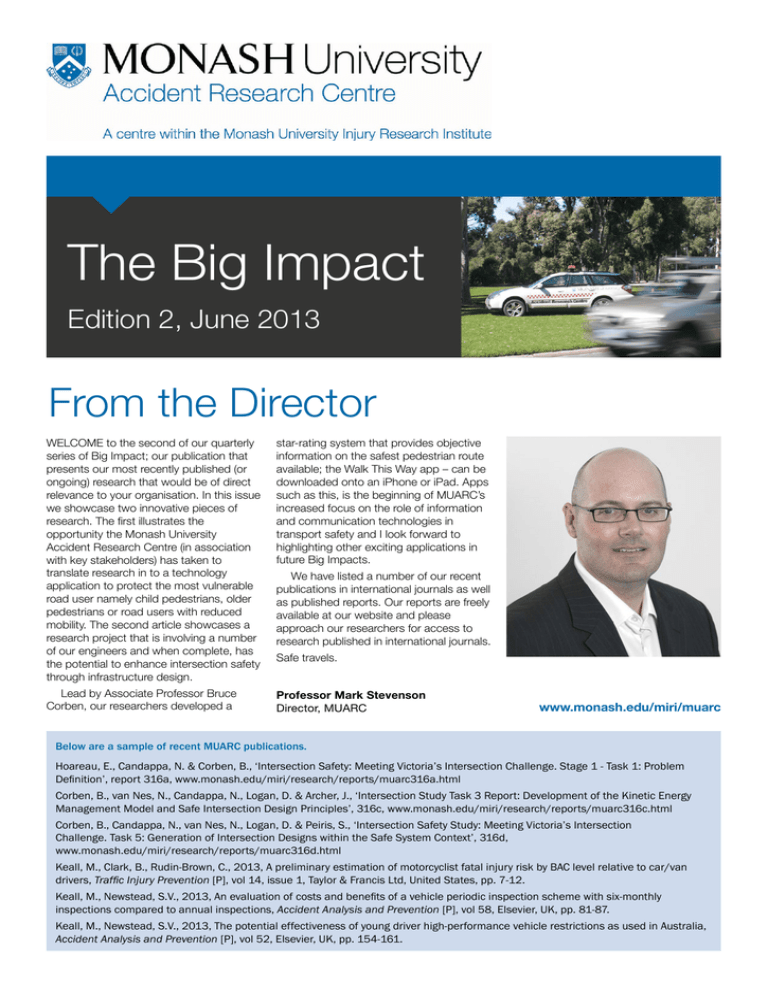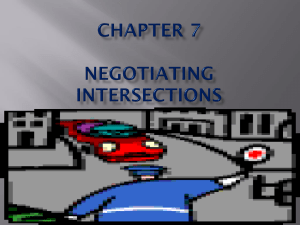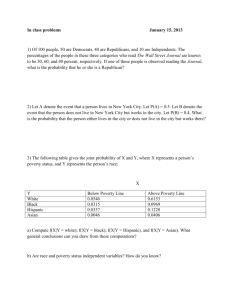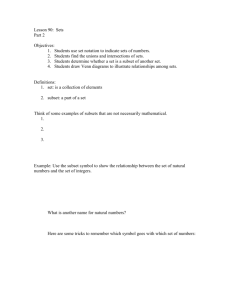The Big Impact From the Director Edition 2, June 2013
advertisement

The Big Impact Edition 2, June 2013 From the Director Welcome to the second of our quarterly series of Big Impact; our publication that presents our most recently published (or ongoing) research that would be of direct relevance to your organisation. In this issue we showcase two innovative pieces of research. The first illustrates the opportunity the Monash University Accident Research Centre (in association with key stakeholders) has taken to translate research in to a technology application to protect the most vulnerable road user namely child pedestrians, older pedestrians or road users with reduced mobility. The second article showcases a research project that is involving a number of our engineers and when complete, has the potential to enhance intersection safety through infrastructure design. star-rating system that provides objective information on the safest pedestrian route available; the Walk This Way app – can be downloaded onto an iPhone or iPad. Apps such as this, is the beginning of MUARC’s increased focus on the role of information and communication technologies in transport safety and I look forward to highlighting other exciting applications in future Big Impacts. Lead by Associate Professor Bruce Corben, our researchers developed a Professor Mark Stevenson Director, MUARC We have listed a number of our recent publications in international journals as well as published reports. Our reports are freely available at our website and please approach our researchers for access to research published in international journals. Safe travels. www.monash.edu/miri/muarc Below are a sample of recent MUARC publications. Hoareau, E., Candappa, N. & Corben, B., ‘Intersection Safety: Meeting Victoria’s Intersection Challenge. Stage 1 - Task 1: Problem Definition’, report 316a, www.monash.edu/miri/research/reports/muarc316a.html Corben, B., van Nes, N., Candappa, N., Logan, D. & Archer, J., ‘Intersection Study Task 3 Report: Development of the Kinetic Energy Management Model and Safe Intersection Design Principles’, 316c, www.monash.edu/miri/research/reports/muarc316c.html Corben, B., Candappa, N., van Nes, N., Logan, D. & Peiris, S., ‘Intersection Safety Study: Meeting Victoria’s Intersection Challenge. Task 5: Generation of Intersection Designs within the Safe System Context’, 316d, www.monash.edu/miri/research/reports/muarc316d.html Keall, M., Clark, B., Rudin-Brown, C., 2013, A preliminary estimation of motorcyclist fatal injury risk by BAC level relative to car/van drivers, Traffic Injury Prevention [P], vol 14, issue 1, Taylor & Francis Ltd, United States, pp. 7-12. Keall, M., Newstead, S.V., 2013, An evaluation of costs and benefits of a vehicle periodic inspection scheme with six-monthly inspections compared to annual inspections, Accident Analysis and Prevention [P], vol 58, Elsevier, UK, pp. 81-87. Keall, M., Newstead, S.V., 2013, The potential effectiveness of young driver high-performance vehicle restrictions as used in Australia, Accident Analysis and Prevention [P], vol 52, Elsevier, UK, pp. 154-161. The safest way to walk to school – a star rating app for parents Childhood obesity is well recognised as a public health issue of significant community concern. Despite physical activity being a key factor in arresting obesity levels, only one in four children walk to school. One of the key factors influencing children’s active travel behaviours are parents and carers who are increasingly concerned about the safety and security of their children walking without the provision of safe crossing opportunities. As a result, many parents and carers prefer to drive children to and from school, to protect them from the heavy traffic conditions surrounding school areas. Between 1974 and 2003, the proportion of students walking to school in Melbourne declined from 45% to 20%, while car travel to school increased from 25% to 70% (VicHealth, 2007). The resulting rise in traffic congestion around schools at pick-up and drop-off times has become a hazard in itself, and parents are reporting increasing concern regarding the volume and speed of cars around schools. Parental fears are, unfortunately, not unfounded. In Victoria from 2009-2012 173 pedestrians were killed of which 17 or 10% were of school age or younger. From September 2008 to August 2012 (the latest stats available) 2521 pedestrians were admitted to hospital with 422 being 17 or younger. These factors all contribute to parents’ feeling that the local environment is not safe enough for their children to be walking to and from school, and so they drive them, further exacerbating the safety and health problems associated. Researchers at the Monash University Accident Research Centre, in partnership with population health professionals at Alfred Health, have developed an app which can advise parents and carers of the safest way for their child to walk to school, in the hope that parents will encourage their children to walk or cycle to school. The pilot study testing the app was reported in the Journal of Public Health last year. In 2008, the MUARC researchers developed a star-rating system that provides objective information that can www.monash.edu/miri/muarc highlight the safest pedestrian route available. The Walk this Way app – which can be downloaded onto an iPhone or iPad – has recently been trialled across four Victorian primary schools. Users are provided with an immediate star rating for a crossing location based on information they submit regarding speed limit, crossing facility, number of traffic directions, traffic volume and number of lanes. Additional consideration is given to environments with traffic calming features and crossing locations with professional supervision. The ratings are calculated with regard to the best available evidence and expert judgement regarding pedestrian death and injury risk. The tool uses Google maps to pinpoint a crossing location and enables users to share their ratings with the broader community. According to Dr David Logan, one of the MUARC researchers involved in the app development, Walk this Way is applicable to all people and settings and is likely to offer highest value in areas relating to children (such as primary schools), older adults or people with reduced mobility. The application can be used on iPhone, iPad or iPod touch and is free to download via the App Store. Four schools in the Glen Eira Area were invited to participate in a trial: Coatesville Primary School; Tucker Road Primary School; St. Aloysius Primary School and St. Peter’s Primary School. An interesting outcome of the pilot study was that participants (students, teachers, parents) had a general tendency to perceive crossings as being safer than what was predicted by the star-rating tool. This difference averaged out to be an approximately two-star gap, indicating that an objective measure – such as the star rating of the Walk this Way app – is important in predicting a safe route to and from school. The majority of parents also reported that the availability of safety information calculated by the star-rating tool would have an influential nature on their decision regarding their child walking to and from school although there were other important key issues highlighted in terms of their decision making process. The Star-Rating Model – What it Means The star rating concept and model development The method incorporated in the model for assessing the safety of crossings was based on the familiar ‘star rating’ concept used in a wide variety of situations, including rating the amenity of hotel accommodation (e.g. STAR Ratings Australia), energy efficiency of electrical appliances and the safety performance of motor vehicles (e.g. Australasian New Car Assessment Program). It is believed that this method of rating provides a clear, simple and user-friendly means of providing safety information to potential users of the tool. The Star Rating Tool combines the five primary factors believed most relevant to pedestrian crash and injury risk and assigns a rating between zero and five stars for the pedestrian crossing in question. The primary factor is driver travel speed, represented for simplicity by speed limit. This factor is modified by the other four factors, namely crossing type, number of conflicting traffic directions, road width and traffic volume. Two additional variables, namely the presence of traffic calming measures and the provision of a crossing supervisor, are used to modify the risk values assigned to speed and crossing type respectively. • Five stars (HHHHH) is considered “much better than average” • Four stars (HHHH) is considered “better than average” • Three stars (HHH) is considered “average” • Two stars (HH) is considered “worse than average” •One star (H) is considered “much worse than average” •No stars is considered “high risk” According to Dr Logan the app can be adapted to any area surrounding a school nationally. “In its current form, the model can be used to assign star ratings to each of the road crossing points along a proposed or existing walking route in order to identify crossing points with a low star rating that should receive priority attention,” he said. “This information can be used to guide the responsible agencies in identifying opportunities for raising safety to levels that are at least acceptable, but preferably commensurate with best-practice standards. The goal should be to have all crossing points achieving four or five stars, with three star points being acceptable but not desirable. It is proposed that crossings with star ratings of two or less would be unacceptable for inclusion on a walk-to-school route and would need to be either improved to at least three, and ideally four or five stars, or a new route defined to exclude these high risk crossing points.” Intersections Intersections are the most dangerous parts of our roads. Crash data suggest that intersections are associated with a higher level of crash risk than with other parts of the road network - largely due to the threatening angles of impact and the high speed at which drivers often approach them. In the last decade, approximately 100,000 people have been seriously injured or killed in intersection crashes in Victoria alone. Intersection safety, therefore, is now recognised as a major road safety concern in Australia and worldwide. One of the main projects of the Monash University Accident Research Centre is a Victorian Government-funded study focussing on improving intersection safety through infrastructural design. While road safety parameters were incorporated into the study – designers and artists were also part of the collaboration in an effort to “think outside the box”. The research team, headed by Associate Professor Bruce Corben, has investigated ways to make intersections safer including • limiting vehicle volumes; • minimising intersection numbers; • minimising conflict points per intersection; and • constraining impact speeds and impact angles to biomechanically tolerable levels. (That is, where intersection angles remain at 90 degrees, impact speeds need to be 50 km/h or less for potential vehicle collisions, and 30 km/h for potential pedestrian collisions; where speeds need to be greater than 50 km/h, intersection angles need to be less than 90 degrees). Through detailed crash analysis three categories of intersections were identified as being particular problem intersection types in Victoria, Australia, either due to sustaining high crash rates, or high absolute crash numbers due to the prevalence of the particular intersection type across the network. These are: • the intersections of urban to urban signalised arterial roads; • the sign-controlled intersections of urban arterial roads with local access roads; • and the sign-controlled intersections of rural highways and low-volume side roads. A collection of designs/approaches were produced in collaboration with well-regarded experts in the field of road safety, as well as with the Arts and Design Faculty of Monash Caulfield, to better facilitate non-conventional, creative u thinking. www.monash.edu/miri/muarc Intersections less than safe traffic manoeuvres. These combined with larger traffic volumes, which increases exposure, and impatience to make it home can produce errors in judgement and significant crashes. Ideas ranged from the obvious (physical barriers to prevent crashes), to the creative (cut through roundabouts) to the more ambitious (LED roundabouts) and non-conventional (reverse roundabouts). Criteria was then included to select from these designs a short-list of designs that could either be trialled immediately, or be investigated further through simulation. This study is one of ten that are currently in place looking at improving the safety of intersections. Are intersections dangerous? From 2000 to 2005, the proportion of serious casualties resulting from intersection crashes per year has consistently remained around 45%. The five crash types identified as being the most frequently involved in serious casualty crashes at Victorian intersections were right turn against, right angle, right-near, rear-end; and run-off-road to the left into an object. The predominate factors found to be associated with serious casualties resulting from intersection crashes were traffic signals, 60 km/h speed zones, afternoon peak, and metropolitan Melbourne. Of the five predominant crash types identified, four have one key element in common: they each involve collisions to the side of the vehicle, the weakest point in the vehicle’s structure. Research suggests side impacts above 50 km/h are likely to result in serious injury. Rear-end crashes are the only crash type that does not involve the side of a vehicle and yet featured prominently in the incidence of serious casualties at intersections. Which intersections are the most dangerous? Traffic signals were recorded as being most involved in crashes producing serious casualties at intersections. Signals are generally only installed at sites with a prescribed minimum volume of traffic, suggesting that likelihood of a crash is greater due to exposure. However, this does not explain the serious nature of the crash outcome, which is more likely due to signals being installed on major arterials that tend to carry higher speed limits. How important are speed zones at intersections? The majority of crashes occurred on 60 km/h zoned roads. This is likely a reflection of the fact that the vehicle kilometreage is greater on these roads. Intersections in 60 km/h zones can carry significant traffic, host varied road users, provide for multifunctions, and attract a wide range of vehicles from cyclists to heavy vehicles, thereby increasing the potential for high severity crash outcomes. Signalised intersections can further exacerbate this based on the higher speeds associated with travelling through them. Is there a safer time of day to travel through an intersection? Afternoon peak was found to be the most likely time for a serious casualty occurring at an intersection. On one hand, this seems surprising as heavy congestion often can slow vehicles, reducing the likelihood of a serious outcome should a crash occur. However, the congestion itself can increase frustration and temptations to beat traffic signals or undertake illegal or Is an intersection safer if it is in the country or the city? In general, more serious casualties were recorded in Metropolitan Melbourne than in the rest of Victoria. The analyses conducted did not reveal any obvious differences between the two regions when compared across the same speed zones. There were, however, a few minor differences. The analyses showed there to be a higher proportion of serious casualties at T-intersections in metropolitan Melbourne in 60, 70 and 80 km/h speed zones than in the same speed zones in the rest of Victoria. The road network in the two zones may possibly be the cause of this. Typically, rural or non-metropolitan road networks have major highways as the main throughput in the area connected by local roads that carry limited traffic volumes. As a result, T-intersections used within these zones are more likely to carry lower speed limits, and a consequent lower potential for serious casualty crashes. Metropolitan road network, on the other hand, tends to rely more heavily on arterial roads for throughput and not just the highways. As a consequence, these roads are likely to carry a higher speed limit associated with roads with a flow function. Further information Monash University Accident Research Centre (MUARC) Building 70, Clayton Campus Monash University, VIC 3800 Telephone: +61 3 9905 4371 Email: miri-enquiry@monash.edu www.monash.edu/miri/muarc




